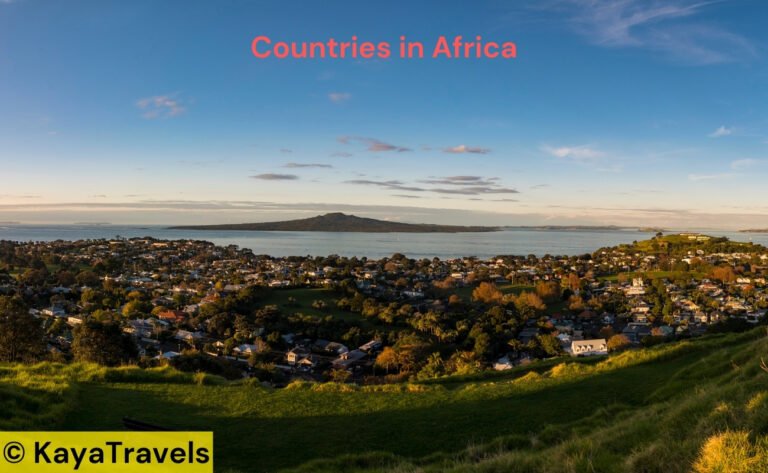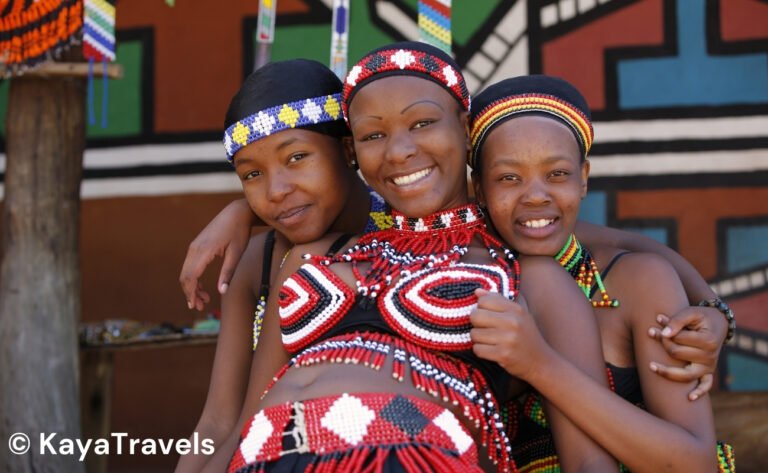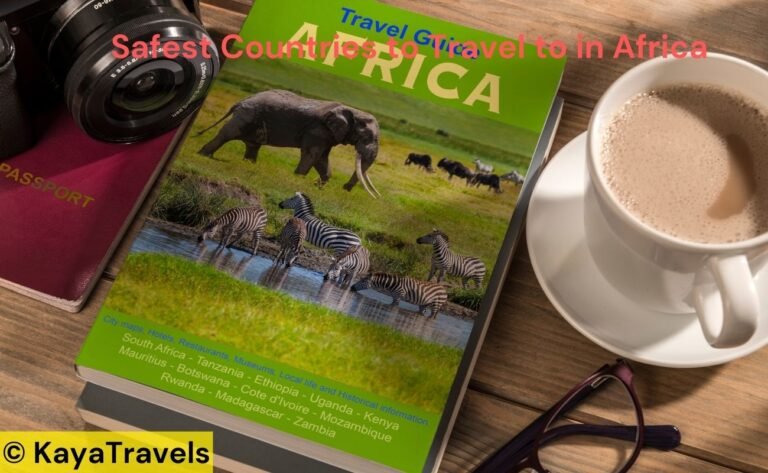Selecting the best time to visit Africa largely depends on your travel goals and the activities you’re interested in. The continent’s vast size means weather patterns and optimal travel times vary significantly across different regions.
Generally, the prime time for a safari in East and Southern Africa is during the dry season, which tends to run from May to October, as wildlife congregates around water sources and vegetation is less dense, improving visibility.
However, if your journey is aimed at North Africa’s historical sites and vibrant m, in that case, for markets, it’s better to plan between October and April when the weather is more relaxed, cooler, and more comfortable for exploring.
It’s also essential to consider specific events or natural phenomena you wish to experience, like the wildebeest migration in the Serengeti, which peaks between June and October, or spotting newborn animals, which is best just after the travelling season.
Remember, travelling during the shoulder seasons can also offer a balance of decent weather, fewer tourists, and lower prices.
Understanding Africa’s Climate
“Africa’s wardrobe has a season for every style,” so knowing when to pack your bags for this vast continent requires understanding its climate. Africa’s weather patterns are diverse, but they can be broken down into simple terms:
- 1. The Rainy and Dry Seasons: Afra experiences a season and a dry season. The wet season, also known as the green season, brings rain to different regions at various times. Rains are crucial for the ecosystem, typically leading to lush landscapes.
- Dry Season: Less rain means sparser vegetation, which can be the ideal time for wildlife viewing as animals congregate around water sources.
Variations Across the Continent:
- North Africa: You’ll find warmer weather year-round, with hot summers and mild winters. Spring (April to June) and Autumn are the best times to visit to avoid extreme heat.
- East Africa: The region is famous for its long rains from March to May and a shorter rainy period around November. The best time for coastal activities is from September to January, while wildlife enthusiasts should consider months like July or October to witness the wildebeest migration.
- Southern Africa: Cooler, dry weather from May to October marks the optimal period for game viewing, especially in large reserves.
Remember, temperatures vary from warm to cold nights, particularly in the north and eastern parts. Prepare for cool evenings and hot days, especially if you travel in the dry seasons between May and August.
Table: Typical Climate Patterns in Africa
| Region | Best to Travel | Climate Note |
|---|---|---|
| North | Apr-Jun, Sep-Oct | Avoid summer heat |
| East | Jul-Oct, Sep-Jan | Ideal for safaris & coast |
| Southern | May-Sep | Optimal for game viewing |
To capture the essence of Africa, timing is everything, and so is your readiness for its climate.
Best Months for African Safaris
Choosing the best time for an African safari can make your wildlife experience unforgettable. The general guideline is to plan your safari during the dry seasons, which vary by region.
In East Africa, particularly Kenya and Tanzania, dry seasons are prime for safaris. These occur from June to October and offer excellent game viewing conditions. You’ll witness the incredible Great Migration in the Serengeti or Maasai Mara in these months.
For Southern Africa, countries like Botswana, Namibia, South Africa, Zambia, and Zimbabwe tend to have their dry season from May to October. Wildlife congregates around water sources, making sightings more common.
However, every country has its nuances:
- South Africa: The winter months of May to September are cooler but great for spotting wildlife.
- Botswana: September is fantastic in places like the Okavango Delta and Chobe National Park.
- Namibia: Offers year-round wildlife encounters, but game viewing peaks in the dry winter months.
- Uganda and Rwanda: For gorilla tracking, consider June to September and December to February.
- Zambia and Zimbabwe: Best viewed from July to October, especially for Victoria Falls and large elephant herds.
Remember that the rainy seasons can affect accessibility but also mean fewer tourists and lower prices. In Kenya, for instance, the long rains are from April to May, and the short rains from November to December may offer occasional showers but still provide quality safari experiences.
When planning your African safari, consider these factors for an adventure filled with bursts of wildlife activity and the natural beauty of Africa’s landscapes.
Learn more about Travel Insurance to Africa.
Regional Travel Recommendations
Discover the ideal times to experience each African region’s unique landscapes and activities.
East and Southern Africa
In East Africa, the prime months to visit are between July and October, perfect for witnessing the great wildebeest migration in Kenya and Tanzania. Coastal activities are also splendid from September to January. Venturing to Southern Africa, countries such as South Africa, Botswana, and Namibia are best visited during the dry season, from May to September, which provides excellent conditions for game viewing.
North Africa
North Africa has a preference for the milder climates of spring and autumn. Touring countries like Morocco and Egypt from April to June or between September and November allows you to avoid the intense heat of summer and the chill of winter months.
West Africa
While not as distinct as safari destinations, West Africa offers a rich tapestry of culture, music, and history. The best time to visit is during the dry season, from November to March, when the weather is more relaxed and outdoor festivals are in full swing.
Note: The regional recommendations aim to provide a concise guide, but always consider checking current local conditions and festivals as they might influence your travel plans.
Wildlife and Natural Phenomena
Timing is critical when planning your African adventure, especially if you’re after a wildlife spectacle. The continent boasts unique animals and natural occurrences, with each region offering distinct experiences at certain times of the year.
The Great Migration: From June to October, witness the phenomenal wildebeest migration in the Serengeti and Masai Mara. Over two million animals traverse these plains, including wildebeest and zebra, in a survival-driven journey.
Gorilla Trekking: Undertake the once-in-a-lifetime experience of tracking mountain gorillas. The best times are during the drier months, from June to September and December to February.
- Victoria Falls: Behold the grandeur of the ‘Smoke That Thunders’ between February and May when the falls are most voluminous, making for stunning rainbows and awe-inspiring views.
- Okavango Delta: Visit during the May to October dry season to see diverse wildlife converging on the delta, creating an oasis of animal activity amid the Kalahari Desert.
Remember, the perfect time to travel is when the experience aligns with your interests. Whether photographing the dynamic movement of the wildebeest migration or enjoying the tranquillity of a luxury safari camp beside the vivid Okavango Delta, Africa’s wildlife and natural phenomena will leave you with unforgettable memories.
Cultural Experiences and Festivals
When you think “it’s the perfect time for an adventure“, Africa should be at the top of your list, especially if you are eager to dive into vibrant cultural experiences and witness spectacular festivals.
Festivals in North Africa: The Atlas Mountains in Morocco set a stunning backdrop for Amazigh New Year, celebrated in January with music, dance, and a bounty of delicious foods, a dazzling showcase of North Africa’s rich Amazigh culture. Meanwhile, Egypt hosts the Sun Festival at Abu Simbel every February and October—two times a year when the sun aligns perfectly to illuminate the inner sanctum of the ancient temple.
- Ethiopian Festivals: Don’t miss out on Ethiopia’s colourful festivals like Timkat in January, which celebrate the Epiphany. Streets fill with processions, jubilant crowds, and the rhythmic beats of traditional music.
In the southern region, various festivals take place throughout the year:
- South Africa’s Winter Months: From July to September, you can attend the National Arts Festival, which transforms Grahamstown into a vibrant hub of creativity.
- Heritage Day: Celebrated in September, it allows you to partake in events across the country that honour the rich tapestry of cultures making up South Africa.
Whether in the heat of the savanna or the cool of the highlands, Africa’s festivals are a window into the soul of its countries.
Insights:
- Join the Amazigh New Year in Morocco’s Atlas Mountains.
- Experience the Sun Festival at Egypt’s Abu Simbel temple – a true marvel.
- Be part of Ethiopia’s Timkat for an authentic cultural plunge.
- Explore South Africa during the National Arts Festival for a diverse cultural collage.
Feel free to immerse yourself in these cultural treasures, as they’re not just events but gateways to understanding the heartbeats of the destinations.






